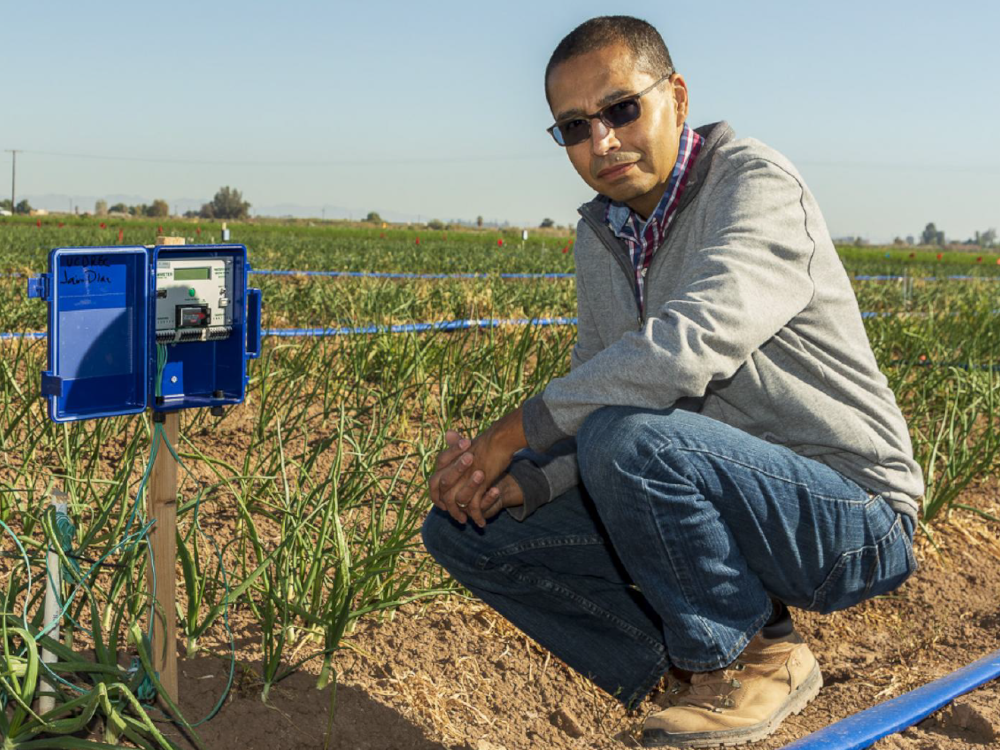Home
Outreach Material
Western Farm Press, 2021. Researchers study onion crop's nitrogen needs
Geisseler, D., Soto Ortiz, R., Diaz, J. 2022. Nitrogen nutrition and fertilization of onions (Allium cepa L.) – A literature review. Scientia Horticulturae
Diaz, J., Geisseler, D., Soto Ortiz, R. 2023. Do wider beds in fresh market onion production increase total water productivity? Progressive Crop Consultant
De la Vega, N. 2023. El riego por goteo ofrece varias ventajas en la producción de cebollas de bola, según un nuevo estudio. UCANR Spanish Noticias.
CDFA-FREP, 2024. Research update: Nitrogen and irrigation managements for onions
Irrigation and Nitrogen Management of Onions in the Low Desert
Highlights
- Fresh market onions reached maximum yields with irrigation at 100% and 130% ETc
- Nitrogen rates that increased available nitrogen in the top foot of the profile to over 105 lb/ac had no effect on yield
- Leaf temperature differential measures detected early water stress
The Team
Jairo Diaz, Roberto Soto Ortiz, Daniel Geisseler.
Background
The Colorado River has been the sole water source of a highly productive agricultural sector in Imperial County, one of the top ten agricultural counties in the nation. Agriculture is the largest water user in the Imperial County. A continuing drought has led to water shortages in recent years. In addition, to prevent soil salinization and enhance agricultural production, agricultural fields in Imperial County have subsurface drainage systems and excess irrigation water is applied to leach salts from the root zone. The drainage water flows into the Salton Sea, which is highly polluted. Improved irrigation and nutrient management practices by growers are needed to optimize water use and minimize pollution from excess nutrients in California's low desert region.
Objectives
The main goal of this project was to evaluate the effects of irrigation management and nitrogen fertilization rates on yield and quality of fresh onion bulb production in arid regions. Specific objectives were:
- Evaluate the response of onion to drip irrigation and regimes and compare onion production under different N fertilizer application rates.
- Communicate findings directly to growers, as well as to crop advisors, academics, regulatory bodies, and agriculture industry.
- Provide training opportunities to college students.
Our Approach
Field trials were performed at the University of California Desert Research and Extension Center in Holtville, CA during three growing seasons from 2019 to 2022. Onions were seeded each year in October and harvested in May or June. A different commercial onion variety was available every year. Sprinklers were used for germination and establishment in all treatments. After establishment, drip irrigation supplied water at four irrigation levels, namely 40, 70, 100, and 130% of crop evapotranspiration (ETc). Four in-season nitrogen treatments were assessed: pre-plant; pre-plant plus 75 lb N/ac; pre-plant plus 150 lb N/ac; and pre-plant plus 225 lb N/ac. The pre-plant nitrogen application rate ranged from 0 to 56 lb/ac, depending on the residual soil nitrate present. Proximal optical sensors (MultispeQ, SC-1 Leaf Porometer, and GreenSeeker) were used during last season to measure crop water stress effects. The trials were carried out with four replicates in a split-plot design with drip irrigation treatments in the main plot and N fertilization rates at the subplot level.
Results
Fresh market onion yields ranged from 15 to 52 t/ac. The trial year contributed most to observed differences, followed by irrigation level and nitrogen application rate.
Onion size, yields, and total soluble solids (brix) were influenced by irrigation rates. Maximum yields were reached in the 100% and 130% ETc treatments. Furthermore, yields of high-value bulbs (jumbo, colossal and supper colossal) were higher in the 100% and 130% ETc treatments.
Onion size distribution, total yield, and firmness did not respond to nitrogen rates when total nitrogen availability in the top foot of the soil exceeded 105 lb/ac. Available nitrogen is the sum of residual soil nitrate at planting and nitrogen applied with fertilizers. However, onion size distribution, total yield, firmness, and brix were negatively affected in a plot with only 54 lb/ac of total nitrogen available in the top foot.
Water deficit regimes significantly decreased stomal conductance, normalized difference vegetation index, leaf temperature differential, and photosynthetic activity. Under water stress conditions, leaves were significantly hotter than those of well irrigated plants. Leaf temperature differential measures detected early water stress.



